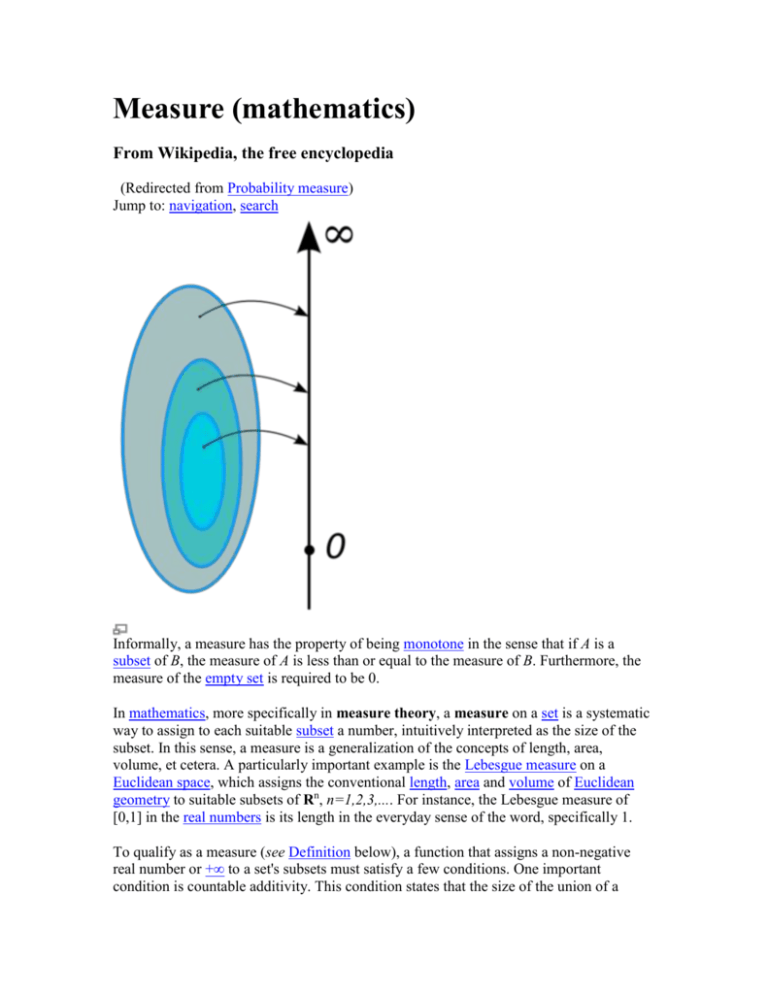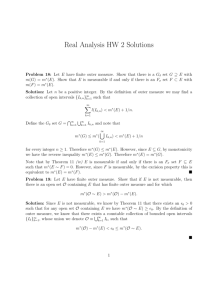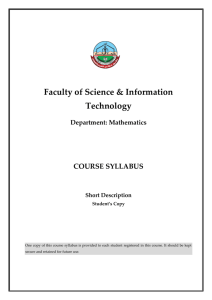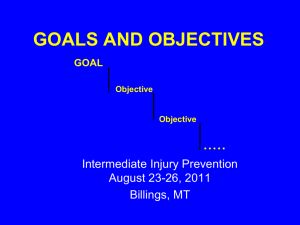Measure (mathematics)
advertisement

Measure (mathematics)
From Wikipedia, the free encyclopedia
(Redirected from Probability measure)
Jump to: navigation, search
Informally, a measure has the property of being monotone in the sense that if A is a
subset of B, the measure of A is less than or equal to the measure of B. Furthermore, the
measure of the empty set is required to be 0.
In mathematics, more specifically in measure theory, a measure on a set is a systematic
way to assign to each suitable subset a number, intuitively interpreted as the size of the
subset. In this sense, a measure is a generalization of the concepts of length, area,
volume, et cetera. A particularly important example is the Lebesgue measure on a
Euclidean space, which assigns the conventional length, area and volume of Euclidean
geometry to suitable subsets of Rn, n=1,2,3,.... For instance, the Lebesgue measure of
[0,1] in the real numbers is its length in the everyday sense of the word, specifically 1.
To qualify as a measure (see Definition below), a function that assigns a non-negative
real number or +∞ to a set's subsets must satisfy a few conditions. One important
condition is countable additivity. This condition states that the size of the union of a
sequence of disjoint subsets is equal to the sum of the sizes of the subsets. However, it is
in general impossible to consistently associate a size to each subset of a given set and also
satisfy the other axioms of a measure. This problem was resolved by defining measure
only on a sub-collection of all subsets; the subsets on which the measure is to be defined
are called measurable and they are required to form a sigma-algebra, meaning that
unions, intersections and complements of sequences of measurable subsets are
measurable. Non-measurable sets in a Euclidean space, on which the Lebesgue measure
cannot be consistently defined, are necessarily complex to the point of
incomprehensibility, in a sense badly mixed up with their complement; indeed, their
existence is a non-trivial consequence of the axiom of choice.
Measure theory was developed in successive stages during the late 19th and early 20th
century by Emile Borel, Henri Lebesgue, Johann Radon and Maurice Fréchet, among
others. The main applications of measures are in the foundations of the Lebesgue
integral, in Andrey Kolmogorov's axiomatisation of probability theory and in ergodic
theory. In integration theory, specifying a measure allows one to define integrals on
spaces more general than subsets of Euclidean space; moreover, the integral with respect
to the Lebesgue measure on Euclidean spaces is more general and has a richer theory
than its predecessor, the Riemann integral. Probability theory considers measures that
assign to the whole set the size 1, and considers measurable subsets to be events whose
probability is given by the measure. Ergodic theory considers measures that are invariant
under, or arise naturally from, a dynamical system.
Contents
[hide]
1 Definition
2 Properties
o 2.1 Monotonicity
o 2.2 Measures of infinite unions of measurable sets
o 2.3 Measures of infinite intersections of measurable sets
3 Sigma-finite measures
4 Completeness
5 Examples
6 Non-measurable sets
7 Generalizations
8 See also
9 References
10 External links
[edit] Definition
Let Σ be a σ-algebra over a set X. A function μ from Σ to the extended real number line is
called a measure if it satisfies the following properties:
Non-negativity:
for all
Null empty set:
Countable additivity (or σ-additivity): For all countable collections {Ei} of
pairwise disjoint sets in Σ:
The second condition may be treated as a special case of countable additivity, if the
empty collection is allowed as a countable collection (and the empty sum is interpreted as
0). Otherwise, if the empty collection is disallowed (but finite collections are allowed),
the second condition still follows from countable additivity provided, however, that there
is at least one set having finite measure.
The pair (X, Σ) is called a measurable space, the members of Σ are called measurable
sets, and the triple (X, Σ, μ) is called a measure space.
If only the second and third conditions are met, and μ takes on at most one of the values
±∞, then μ is called a signed measure.
A probability measure is a measure with total measure one (i.e., μ(X) = 1); a probability
space is a measure space with a probability measure.
For measure spaces that are also topological spaces various compatibility conditions can
be placed for the measure and the topology. Most measures met in practice in analysis
(and in many cases also in probability theory) are Radon measures. Radon measures have
an alternative definition in terms of linear functionals on the locally convex space of
continuous functions with compact support. This approach is taken by Bourbaki (2004)
and a number of other authors. For more details see Radon measure.
[edit] Properties
Several further properties can be derived from the definition of a countably additive
measure.
[edit] Monotonicity
A measure μ is monotonic: If E1 and E2 are measurable sets with E1 ⊆ E2 then
[edit] Measures of infinite unions of measurable sets
A measure μ is countably subadditive: If E1, E2, E3, … is a countable sequence of sets in
Σ, not necessarily disjoint, then
A measure μ is continuous from below: If E1, E2, E3, … are measurable sets and En is a
subset of En + 1 for all n, then the union of the sets En is measurable, and
[edit] Measures of infinite intersections of measurable sets
A measure μ is continuous from above: If E1, E2, E3, … are measurable sets and En + 1 is a
subset of En for all n, then the intersection of the sets En is measurable; furthermore, if at
least one of the En has finite measure, then
This property is false without the assumption that at least one of the En has finite
measure. For instance, for each n ∈ N, let
which all have infinite Lebesgue measure, but the intersection is empty.
[edit] Sigma-finite measures
Main article: Sigma-finite measure
A measure space (X, Σ, μ) is called finite if μ(X) is a finite real number (rather than ∞). It
is called σ-finite if X can be decomposed into a countable union of measurable sets of
finite measure. A set in a measure space has σ-finite measure if it is a countable union of
sets with finite measure.
For example, the real numbers with the standard Lebesgue measure are σ-finite but not
finite. Consider the closed intervals [k,k+1] for all integers k; there are countably many
such intervals, each has measure 1, and their union is the entire real line. Alternatively,
consider the real numbers with the counting measure, which assigns to each finite set of
reals the number of points in the set. This measure space is not σ-finite, because every set
with finite measure contains only finitely many points, and it would take uncountably
many such sets to cover the entire real line. The σ-finite measure spaces have some very
convenient properties; σ-finiteness can be compared in this respect to the Lindelöf
property of topological spaces. They can be also thought of as a vague generalization of
the idea that a measure space may have 'uncountable measure'.
[edit] Completeness
A measurable set X is called a null set if μ(X)=0. A subset of a null set is called a
negligible set. A negligible set need not be measurable, but every measurable negligible
set is automatically a null set. A measure is called complete if every negligible set is
measurable.
A measure can be extended to a complete one by considering the σ-algebra of subsets Y
which differ by a negligible set from a measurable set X, that is, such that the symmetric
difference of X and Y is contained in a null set. One defines μ(Y) to equal μ(X).
[edit] Examples
Some important measures are listed here.
The counting measure is defined by μ(S) = number of elements in S.
The Lebesgue measure on R is a complete translation-invariant measure on a σalgebra containing the intervals in R such that μ([0,1]) = 1; and every other
measure with these properties extends Lebesgue measure.
Circular angle measure is invariant under rotation.
The Haar measure for a locally compact topological group is a generalization of
the Lebesgue measure (and also of counting measure and circular angle measure)
and has similar uniqueness properties.
The Hausdorff measure which is a refinement of the Lebesgue measure to some
fractal sets.
Every probability space gives rise to a measure which takes the value 1 on the
whole space (and therefore takes all its values in the unit interval [0,1]). Such a
measure is called a probability measure. See probability axioms.
The Dirac measure δa (cf. Dirac delta function) is given by δa(S) = χS(a), where χS
is the characteristic function of S. The measure of a set is 1 if it contains the point
a and 0 otherwise.
Other 'named' measures used in various theories include: Borel measure, Jordan measure,
ergodic measure, Euler measure, Gaussian measure, Baire measure, Radon measure.
[edit] Non-measurable sets
Main article: Non-measurable set
If the axiom of choice is assumed to be true, not all subsets of Euclidean space are
Lebesgue measurable; examples of such sets include the Vitali set, and the nonmeasurable sets postulated by the Hausdorff paradox and the Banach–Tarski paradox.
[edit] Generalizations
For certain purposes, it is useful to have a "measure" whose values are not restricted to
the non-negative reals or infinity. For instance, a countably additive set function with
values in the (signed) real numbers is called a signed measure, while such a function with
values in the complex numbers is called a complex measure. Measures that take values in
Banach spaces have been studied extensively. A measure that takes values in the set of
self-adjoint projections on a Hilbert space is called a projection-valued measure; these
are used mainly in functional analysis for the spectral theorem. When it is necessary to
distinguish the usual measures which take non-negative values from generalizations, the
term positive measure is used. Positive measures are closed under conical combination
but not general linear combination, while signed measures are the linear closure of
positive measures.
Another generalization is the finitely additive measure, which are sometimes called
contents. This is the same as a measure except that instead of requiring countable
additivity we require only finite additivity. Historically, this definition was used first, but
proved to be not so useful. It turns out that in general, finitely additive measures are
connected with notions such as Banach limits, the dual of L∞ and the Stone–Čech
compactification. All these are linked in one way or another to the axiom of choice.
A charge is a generalization in both directions: it is a finitely additive, signed measure.
The remarkable result in integral geometry known as Hadwiger's theorem states that the
space of translation-invariant, finitely additive, not-necessarily-nonnegative set functions
defined on finite unions of compact convex sets in Rn consists (up to scalar multiples) of
one "measure" that is "homogeneous of degree k" for each k = 0, 1, 2, ..., n, and linear
combinations of those "measures". "Homogeneous of degree k" means that rescaling any
set by any factor c > 0 multiplies the set's "measure" by ck. The one that is homogeneous
of degree n is the ordinary n-dimensional volume. The one that is homogeneous of degree
n − 1 is the "surface volume". The one that is homogeneous of degree 1 is a mysterious
function called the "mean width", a misnomer. The one that is homogeneous of degree 0
is the Euler characteristic.
[edit]











